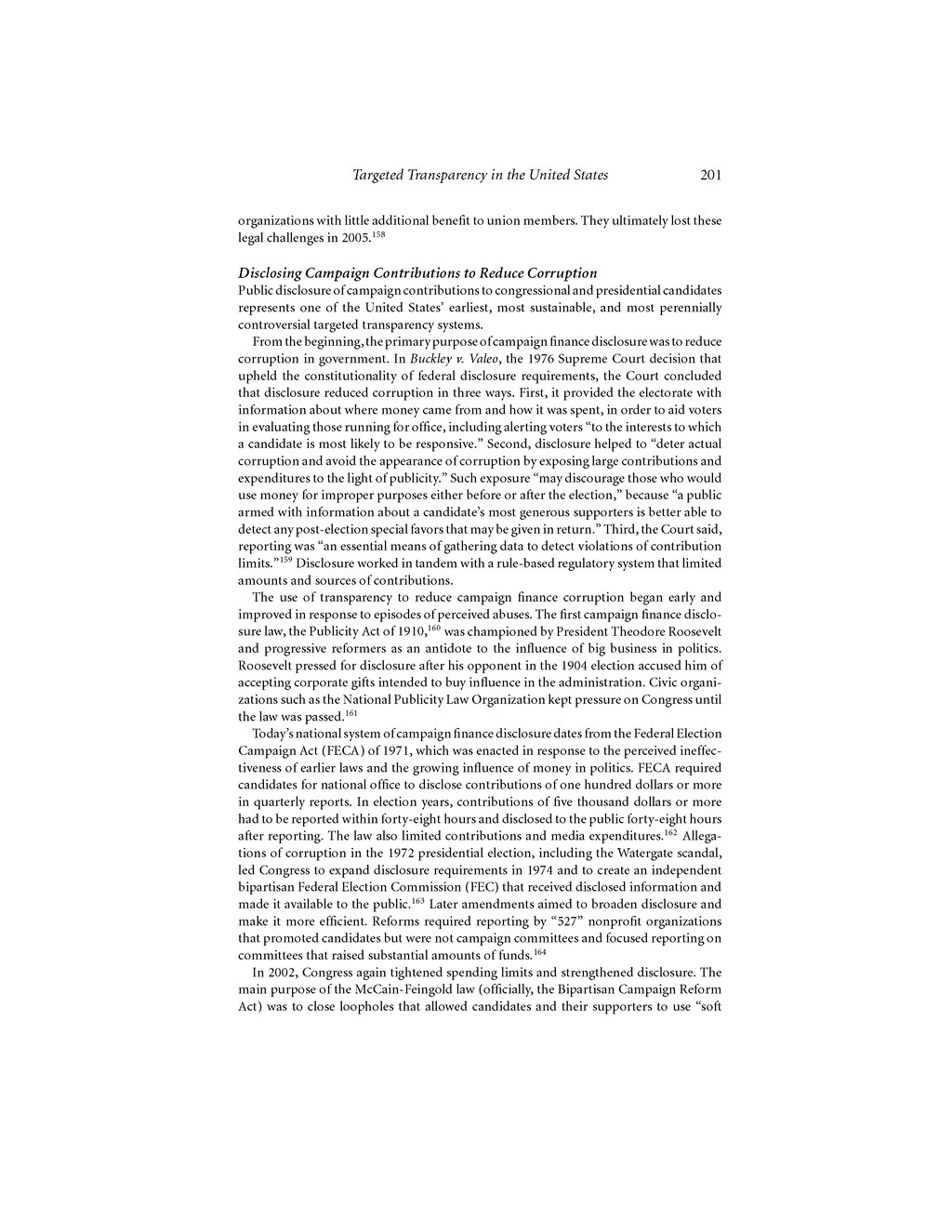organizations with little additional benefit to union members. They ultimately lost these legal challenges in 2005. 158
Disclosing Campaign Contributions to Reduce Corruption
Public disclosure of campaign contributions to congressional and presidential candidates represents one of the United States’ earliest, most sustainable, and most perennially controversial targeted transparency systems.
From the beginning, the primary purpose of campaign finance disclosure was to reduce corruption in government. In Buckley v. Valeo, the 1976 Supreme Court decision that upheld the constitutionality of federal disclosure requirements, the Court concluded that disclosure reduced corruption in three ways. First, it provided the electorate with information about where money came from and how it was spent, in order to aid voters in evaluating those running for office, including alerting voters “to the interests to which a candidate is most likely to be responsive.” Second, disclosure helped to “deter actual corruption and avoid the appearance of corruption by exposing large contributions and expenditures to the light of publicity.” Such exposure “may discourage those who would use money for improper purposes either before or after the election,” because “a public armed with information about a candidate’s most generous supporters is better able to detect any post-election special favors that may be given in return.” Third, the Court said, reporting was “an essential means of gathering data to detect violations of contribution limits.” 159 Disclosure worked in tandem with a rule-based regulatory system that limited amounts and sources of contributions.
The use of transparency to reduce campaign finance corruption began early and improved in response to episodes of perceived abuses. The first campaign finance disclosure law, the Publicity Act of 1910, 160 was championed by President Theodore Roosevelt and progressive reformers as an antidote to the influence of big business in politics. Roosevelt pressed for disclosure after his opponent in the 1904 election accused him of accepting corporate gifts intended to buy influence in the administration. Civic organizations such as the National Publicity Law Organization kept pressure on Congress until the law was passed. 161
Today’s national system of campaign finance disclosure dates from the Federal Election Campaign Act (FECA) of 1971, which was enacted in response to the perceived ineffectiveness of earlier laws and the growing influence of money in politics. FECA required candidates for national office to disclose contributions of one hundred dollars or more in quarterly reports. In election years, contributions of five thousand dollars or more had to be reported within forty-eight hours and disclosed to the public forty-eight hours after reporting. The law also limited contributions and media expenditures. 162 Allegations of corruption in the 1972 presidential election, including the Watergate scandal, led Congress to expand disclosure requirements in 1974 and to create an independent bipartisan Federal Election Commission (FEC) that received disclosed information and made it available to the public. 163 Later amendments aimed to broaden disclosure and make it more efficient. Reforms required reporting by “527” nonprofit organizations that promoted candidates but were not campaign committees and focused reporting on committees that raised substantial amounts of funds. 164
In 2002, Congress again tightened spending limits and strengthened disclosure. The main purpose of the McCain-Feingold law (officially, the Bipartisan Campaign Reform Act) was to close loopholes that allowed candidates and their supporters to use “soft
